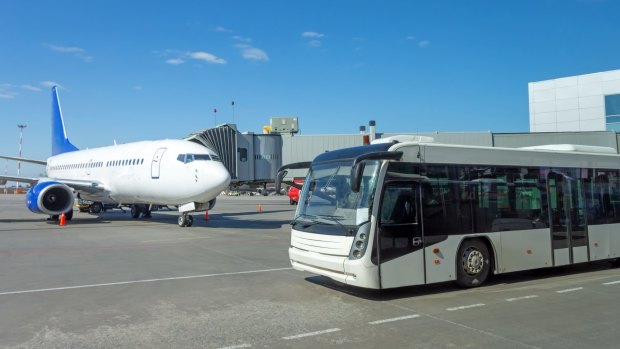This was published 1 year ago
Why some airports use buses to transport passengers to planes
By Michael Gebicki

Passengers being bussed to their planes is uncommon at Australian airports, but happens a lot overseas.Credit: iStock
Watching your flight take off without you is a sobering experience, but that's what happened to 55 passengers on a shuttle bus heading across the tarmac to their aircraft when it started moving across the tarmac at India's Bengaluru Airport.
"Why aren't you on board?" messaged a passenger on the Delhi-bound aircraft to Neeraj Bhat, his friend on the bus, but there was nothing to be done. The airline operating the flight, Go First, apologised profusely, booked passengers on a following flight, stood down the staff responsible and offered a free flight on the airline's domestic network to affected passengers but Bhat wasn't biting.
"Maybe they should rename the airline 'Go Now'", he said.
Have you ever had a flight that began with a bus ride to the plane? Probably not in Australia, here passengers usually board their aircraft via an airbridge, or a short walk across the tarmac for rear-boarding on stairs, but at European airports shuttle buses between terminal and aircraft are common.
Especially flying aboard low-cost carriers. London's Heathrow Airport charges between £13.42 ($23.65) and £20.92 ($36.90) for every passenger departing for a European destination, but there is a discount of £4 ($7) per passenger for aircraft operating from a remote stand, i.e. not connected to the terminal via an airbridge.
Speed is another reason. If you want to turn an aircraft around quickly, stairs and shuttle buses are the way to go, and turnaround time is money for a budget carrier. Loading and unloading via stairs means that aircraft don't have to wait for an airbridge to connect before disembarking passengers. When our interstate lockdowns lifted and carriers such as Qantas were re-learning how to operate an airline, it was not uncommon to wait for 10 minutes or more after the engines stopped for an airbridge to be connected.
Another advantage of stairs – when passengers are on board and seated, aircraft can start moving under their own power without waiting for pushback from a tug, a time saver. Even better if an aircraft can deploy its own stairs from the fuselage. One of the options on the Boeing 737 is internal staircases at front and rear, which can unfold without relying on ground-based services. Ryanair, with a fleet of almost 600 Boeing 737s, is a major customer for this option, and that's one reason Ryanair's turnaround times are as short as 25 minutes.
Unlikely in the US
Buses between aircraft and terminal are uncommon in the US, used by only 21 airports in that country according to the Port of Seattle. That's despite US airports being the world's busiest measured by the number of aircraft movements. Some unkind social media posters have suggested the reason might be because Americans are so unfit that a staircase would present major problems for loading and unloading, but flyers would regard stairs as a service deficiency. Americans want an airbridge, end of story.
Seattle-Tacoma International Airport (Sea-Tac) is one of the few that bus passengers between aircraft and terminal. The reason is the rapid expansion in visitor traffic as the port of Seattle has become a gateway for the Alaska cruise industry. In April 2022 Sea-Tac completed a $US3.3billion ($4.7billion) expansion project that increased the number of international gates from 12 to 20 but despite the upgrade Sea-Tac is still bussing passengers to and from aircraft.
An airport can boom when a destination experiences a surge in popularity. That's happened in Istanbul, Iceland's Reykjavik and Bengaluru (Bangalore) in India. But while air traffic can increase overnight, adding facilities to handle the extra traffic is often a decade-long process. The ideal solution is a new airport, but that's even longer (hello, Sydney!). Seattle is looking to build a second international airport but that probably won't open before 2040. When an airport suddenly finds itself with too few gates and airbridges, bussing is a quick fix.
A different kind of bus
The shuttle buses used are specialised vehicles unlike any other bus. Ground clearance is minimal since they're only negotiating flat surfaces, with just one small step onto the floor of the bus. There are few seats. It's a short ride and the priority is packing in as many bodies as possible, passenger comfort comes way down the list. For the same reason they're wider and longer than public transport buses, and capable of transporting as many as 160 passengers, about three times the number on a typical city bus. Usually there are doors on both sides, as many as three per side and they're wide.
Airlines tend to pack their shuttle buses tightly. While it's not something to look forward to after a long flight, for some travellers it's a fun ride. From ant level, you're looking up at the undersides of giant aircraft, enormous wheels and engines that inhale an inlet air mass flow of 1000 kgs per second. It's hard not to be awed.
World's busiest airports by aircraft movements
- Atlanta, Georgia
- Chicago, Illinois
- Dallas/Fort Worth, Texas
- Denver, Colorado
- Charlotte, North Carolina
- Los Angeles, California
- Las Vegas, Nevada
- Phoenix, Arizona
- Miami, Florida
- Houston, Texas
Based on the latest available figures (2021) from the Airports International Council
See also: Sydney-Melbourne routes surge back into world's busiest
See also: Traveller's airport reviews
Sign up for the Traveller newsletter
The latest travel news, tips and inspiration delivered to your inbox. Sign up now.